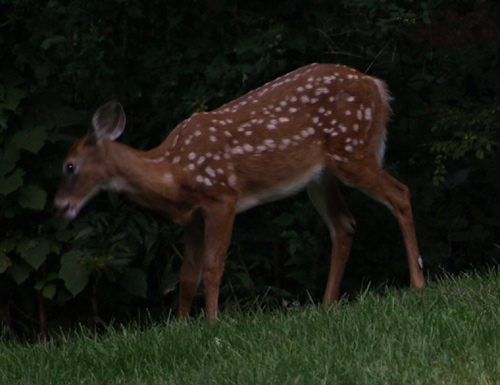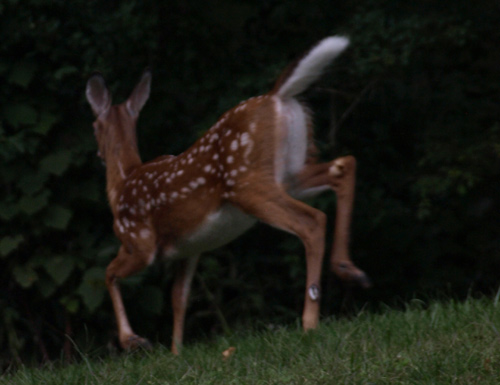White-tailed deer are very common in Connecticut. They have tan/brown coats with white fur on their belly, inside their ears and, as noted in their name, under the tail. The white tail is raised when the deer is frightened or running and is believed to act as an alrm signal. There is also a bit of white around their nose and eyes. Baby deer, fawns, have white spots on their coats for added camouflage. The baby coat is shed in the fawn's first autumn at about 6 months of age, but sometimes the new coat retains a few sets of spots near the backbone. White-tailed deer weigh about 100 to 300 lbs and stand 3 to 4 feet tall at the shoulder.
Male deer, bucks, begin to grow antlers in April in New England. They reach their full size in late summer when the skin covering them and supplying the growing bone with blood, called velvet, dries up and falls off. Males use their antlers as display and weaponry against other males as they compete for does during the breeding season in late November to December. When breeding season is over, the deer lose their antlers in the winter. The cycle begins again the next spring.
White-tailed deer are almost everywhere in the continental US, except for a region in the southwest. They are present in southern Canada and the northern edge of Mexico as well. There are so many around that people may find them to be a nuisance as they go about eating flowers and vegetables in gardens and becoming obstacles on the roads for drivers. The deer don't have anywhere else to live now that humans have encroached on their habitat. We have have gotten rid of many of their natural predators as well. I'd certainly rather live with the deer than without them. If we insist on planting tasty treats in our yards, who is a deer to say no?
Deer eat wild green plants, acorns and other tree nuts, and your favorite ornamentals or food plants in the summer. In winter they browse on twigs, buds and bark.
Mating season is in late November to December. Fawns will be born most often in late May or early June in Connecticut. Most of the time a doe will give birth to twins although they may also produce singles, triplets, or even qradruplets. A mother deer will leave her very young fawn alone in the days after it is born except to nurse. Her presence and scent may give away its location. The fawn's defense is to curl up in cover where its mother has hidden it and not move, relying on its dappled coat and lack of body scent to hide it. Sometimes people come across these adorable little beasties and think they have been abandoned. The best thing to do is to leave the fawn alone. Mother is likely nearby and too afraid of you to come back. Do not touch a baby deer. In this case, unlike that of baby birds, it is indeed true that the scent of humans on the baby may cause the mother to abandon it.
With their delicate and graceful appearance, white-tail deer are lovely animals. They are usually seen by people in the very early morning or at dusk. They can be active during the day, but are mostly nocturnal.
Neat Facts
The size and number of points on a deer's antlers are not necessarily indicative of his age. Nutrition has a greater impact on the splendor of a buck's antlers than age, although older bucks who have reached their maximum body size do tend to grow bigger antlers.
With so many deer around, you may wonder why the ground is not simply littered with fallen antlers in winter. These discarded bits of bone are a good source of calcium for many of the local rodents. Mice and squirrels gnaw them up rather quickly.
In the Florida Keys, a population of white-tailed deer is believed to have migrated across land bridges to the islands thousands of years ago. Isolated from the rest of the population they have diminished in stature and now are a miniature version of the ubiquitous white-tailed deer. This tiny subspecies, Key Deer, Odocoileus virginianus clavium, is at risk with a population of only around 700. Key Deer stand only 2 to 3 feet high at the shoulder and weigh 65 to 80 lbs.

